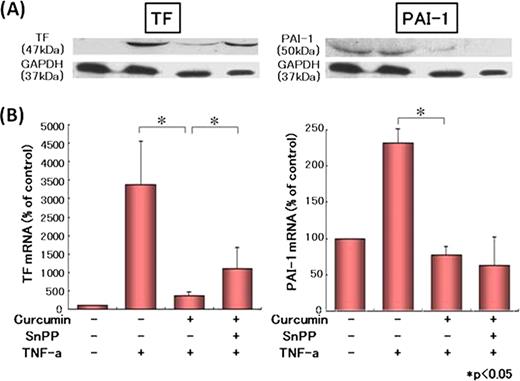Abstract
Abstract 3333
Curcumin (diferuloyl methane), an active component of the spice turmeric, has been shown to exhibit anti-inflammatory and antioxidant activities in addition to an anticartinogenic activity in vitro and in vivo. Recent studies reported that curcumin acts as a non-stressful and non-cytotoxic inducer of the cytoprotective heme oxigenase-1 (HO-1). HO-1 is an inducible enzyme which degrades oxidative heme into biliverdin, free iron, and carbon monoxide. The first human case of HO-1 deficiency was described from Japan by Yachie, et al (J Clin Invest 1999; 103:129). This HO-1 deficient child exhibited severe persistent endothelial damage and extremely hyper-coagulable state. These findings prompted us to study roles of HO-1 in the regulation of coagulability. Epstein-Barr virus-transformed lymphoblastoid cell line (LCL) derived from the HO-1 deficient patient was not able to produce HO-1 production at all. In comparison to control LCLs, the HO-1 deficient LCLs expressed markedly higher levels of tissue factor (TF) mRNA and protein (2-fold, p<0.05) as well as of plasminogen activator inhibitor type 1 (PAI-1) (2-fold, p<0.05), upon exposure to oxidative stress such as hemin, suggested important roles of HO-1 or HO-1 products in the regulating of coagulation and fibrinolytic system. We then hypothesized that endothelial HO-1 induced by curcumin may ameliorate hyper-coagulable state associated with inflammation or oxidative stress. The exposure of human umbilical vein endothelial cells (HUVECs) to curcumin (15 mM) for 6 hr resulted in a significant increase in the level of both HO-1 mRNA (15-fold) and protein. The treatment of HUVECs with 15 mM curcumin for 3hr before stimulation with tumor necrosis factor-α (TNF-α, 10 ng/ml) for additional 5hr markedly inhibited TNF-a-induced expression of TF (approximately 90 % suppression) and PAI-1 (approximately 70 % suppression) (Figure1). The inhibitory effect of curcumin on the TF expression was partially abrogated by tin protoporphyrin IX (SnPP) (20 mM), an inhibitor of heme oxigenase activity, indicating that the curcumin-induced suppression of TF is partly mediated by HO-1 (Figure 1). Moreover, curcumin inhibited TNF-a-induced phosphorylation of p38 mitogen-activated protein kinase (MAPK), extracellular signal-regulated kinase 1and 2 (ERK1/2), and c-Jun N-terminal kinase (JNK), indicating the inhibition of these signal pathways may also be responsible for the suppression of TF/PAI-1 expressions in HUVECs by curcumin. In conclusion, these results indicate that curcumin exerts anti-thrombotic effects directly and indirectly through the induction of HO-1. Curcumin may serve as a novel anti-thrombotic agent for the treatment of hyper-coagulable state or thrombus formation associated with inflammation.
Figure 1. Effects of curcumin on TNF-α-induced TF and PAI-1 protein (A) and mRNA (B) expression in HUVECs. The columns represent the mean ± SD (n=3) percentages of the control culture. *p<0.05 versus TNF-α alone.
No relevant conflicts of interest to declare.
Author notes
Asterisk with author names denotes non-ASH members.


This feature is available to Subscribers Only
Sign In or Create an Account Close Modal